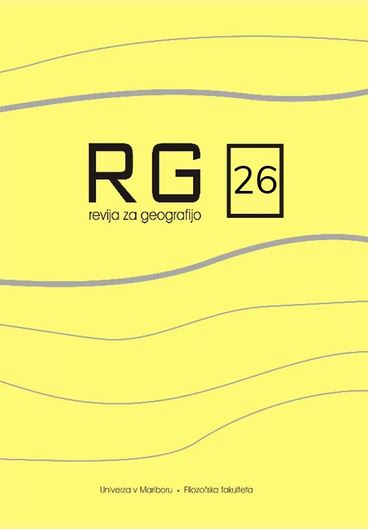The magnitude of climate change in Natura 2000 areas in Slovenia
DOI:
https://doi.org/10.18690/rg.13.2.3712Keywords:
change vector analysis, climate change, Natura 2000, SloveniaAbstract
Europe has the world's largest network of protected areas. Of course, climate change affects these areas no less than others. However, scientists reported that forecasts on maintaining climatic suitability for species of European concern in some Natura 2000 areas across Europe are even worse compared to surrounding unprotected areas. From the Slovenian perspective, the most climate change exposed Natura 2000 areas, according to current forecasts, can be found in the Sub-Mediterranean or Sub-Pannonia regions. More stable bioclimatic conditions, as expected, are estimated in the uplands. Such studies, which offer an objective assessment of the impact of climate change in the area, are of immense importance to managers and decision-makers in protected areas in order to prepare and potentially implement mitigation measures on the relevant vulnerable areas.
Downloads
References
Araújo, M.B., Alagador, D., Cabeza, M., Nogués-Bravo, D., Thuiller, W., 2011. Climate change threatens European conservation areas. Ecology Letters, 14, 484-492. https://doi.org/10.1111/j.1461-0248.2011.01610.x
Bertzky, M., Dickson, B., Galt, R., Glen, E., Harley, M., Hodgson, N., Keder, G., Lysenko, I., Pooley, M., Ravilious, C., Sajwaj, T., Schiopu, R., Soye, Y., Tucker, G., 2011. Impacts of climate change and selected renewable energy infrastructures on EU biodiversity and the Natura 2000 network -Summary Report. URL: http://ec.europa.eu/environment/nature/climatechange/pdf/study.pdf .
Direktiva Sveta o ohranjanju naravnih habitatov ter prosto živečih živalskih in rastlinskih vrst (92/43/EGS). 1992. URL: https://eur-lex.europa.eu/LexUriServ/LexUriServ.do?uri=CELEX:31992L0043:SL:HTML (16. 11. 2018).
Direktiva Sveta o hranjanju prosto živečih ptic (79/409/EGS). 1979. URL:
https://eur-lex.europa.eu/LexUriServ/LexUriServ.do?uri=CELEX:31979L0409:SL:HTML (16. 11. 2018).
Eastman, J.R. 2016. TerrSet, Clark Labs-Clark University, Worcester, 45.
Ellwanger, G., Ssymank, A., Paulsch, C., 2012. Natura 2000 and Climate Change - a Challenge. Münster, Germany, Landwirtschaftsverlag, 201 str. URL:
https://www.researchgate.net/publication/278675343_Natura_2000_and_Climate_Change_-_a_Challenge.
ESRI, 2018. ArcGIS Desktop: Release 10.6. Redlands, CA: Environmental Systems Research Institute.
Foden, W.B., Butchart, S.H.M., Stuart, S.N., Vie´ J-C, Akcakaya, H.R., in sod. 2013. Identifying the World’s Most Climate Change Vulnerable Species: A Systematic
Trait-Based Assessment of all Birds, Amphibians and Corals. PLoS ONE 8(6): e65427. https://doi.org/10.1371/journal.pone.0065427.
Fuller, R.A., McDonald-Madden, E., Wilson, K.A., Carwardine, J., Grantham, H.S., Watson, J.E.M. in sod. 2010. Replacing underperforming protected areas achieves better conservation outcomes. Nature, 466, 365–367. https://doi.org/10.1038/nature09180
Geoportal ARSO. Agencija RS za okolje. URL: https://gis.arso.gov.si/geoportal/catalog/main/home.page (16. 11. 2018).
Harley, M. in van Minnen., J. 2010a. Adaptation Indicators for Biodiversity. ETC/ACC. Techinical Paper 2010/15.
Harley M., Chambers, T., Hodgson, N., van Minnen, J., & Pooley, M. 2010b. A methodology for assessing the vulnerability to climate change of habitats in the Natura 2000 network. ETC/ACC Technical Paper 2010/14.
Howard, C., Stephens, P.A., Tobias, J.A., Sheard, C., Butchart, S.H.M., Willis, S.G. 2018. Flight range, fuel load and the impact of climate change on the journeys of migrant birds. Royal Society Publishing, str. 285. http://dx.doi.org/10.1098/rspb.2017.2329
Johnson, R.D., Kasischke, E.S. 1998. Change vector analysis: A technique for the multispectral monitoring of land cover and condition. Internationall Journal for Remote Sensing 19(3):411–426. https://doi.org/10.1080/014311698216062
Krystufek, B., Zorenko, T.A., Bontzorlos, V., Mahmoudi, A., Atanasov, N., Ivajnšič, D. 2018. Incipient road to extinction of a keystone herbivore in south-eastern Europe: Harting’s vole (Microtus hartingi) under climate change. Climatic Change,149(3-4),443-354. https://doi.org/10.1007/s10584-018-2259-2
Lilles, T.M., Kiefer, R.W., Chipman, J.W. 2004. Remote Sensing and Image Interpretation. John Wiley & Sons.
Loarie, S.R., Duffy, P.B., Hamilton, H., Asner, G.P., Field, C.B., Ackerly, D.D. 2009. The velocity of climate change. Nature, 462, 1052–1055.
Permesan, C., Yohe, G. 2003. A globally coherent fingerprint of climate change impacts across natural systems. Nature, 421, 37-42.
Peterson, A.T. 2003. Projected climate change effects on Rocky Mountain and Great Plain birds: generalities of biodiversity consequences. Global Change Biology, 9, 647–655. https://doi.org/10.1046/j.1365-2486.2003.00616.x
Sanderson, B.M., Knutti, R. & Caldwell, P. 2015. A Representative Democracy to Reduce Interdependency in a Multimodel Ensemble. Journal of Climate, 28, 5171–5194. https://doi.org/10.1175/JCLI-D-14-00362.1
Sajwaj T, G. Tucker, M. Harley, de Soye, Y. 2009 . Impacts of climate change and selected renewable energy infrastructures on EU biodiversity and the Natura 2000 network. Task 2a – An assessment framework for climate change vulnerability: methodology and results. AEA.
Trouwborst A. 2011. Conserving European Biodiversity in a Changing Climate: The Bern Convention, the EU Birds and Habitats Directives and the Adaptation of Nature to Climate Change, 20(1) Review of European Community and International Environmental Law, pp. 62-77.
Medmrežje 1: Natura 2000. Evropska Komisija. 2009. URL: http://ec.europa.eu/environment/nature/info/pubs/docs/nat2000/factsheet_sl.pdf (15. 11. 2018).
Medmrežje 2: Worldclim podatkovna baza. URL: http://worldclim.org/ (15.11.2018)
Medmrežje 3: Natura 2000 v Sloveniji. URL: http://www.natura2000.si/o-naturi-2000/natura-2000-v-sloveniji/ (3. 11. 2018).
Downloads
Published
Issue
Section
License
Copyright (c) 2018 Danijel Ivajnšič, Daša Donša

This work is licensed under a Creative Commons Attribution 4.0 International License.
